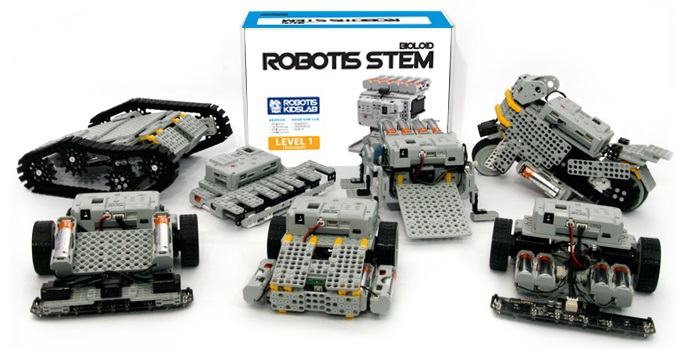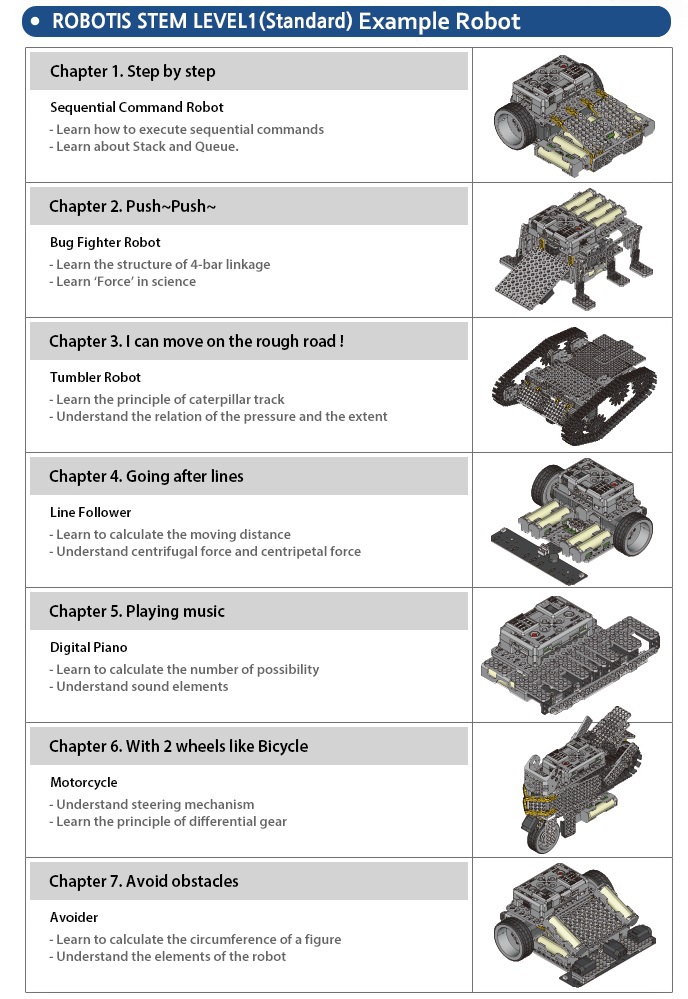
.
ROBOTIS STEM LEVEL 1

Learn the principles of STEM (Science, Technology, Engineering, and Mathematics) with theROBOTIS STEM Level 1, a comprehensive introductory robotics kit geared for high-school. The kit features the following parts:

Building the ROBOTIS STEM Level 1 Examples
You can build up to (7) example robots with the ROBOTIS STEM Level 1 kit:

The kit includes fully-colored workbooks that provide detailed assembly instructions. Alternatively, you can download the R+ Design program for a preview of robot assembly and structure. Zoom in/out or rotate the 3D model to view the robot from any angle.
|
|
For assembly tips, please check out our Tutorial Videos! (Coming Soon!)
Programming the ROBOTIS STEM Level 1 Examples
|
The ROBOTIS STEM Level 1 can be programmed using RoboPlus. The kit comes with a download CD but you can also download it here.
For programming ROBOTIS STEM Level 1, you will need RoboPlus Task, which is included in the the RoboPlus suite. Alternatively, you can download the new version of RoboPlus Task, R+ Task 2.0here.
|
|
Download Example Programs
|
Chapter 1: Sequence Racer
|
Basic Phase (.tsk) |
| Application Phase (.tsk) | |
| Practical Phase (.tsk) | |
|
Chapter 2: Bug Fighter
|
Basic Phase (.tsk) |
| Application Phase (.tsk) | |
| Practical Phase (.tsk) | |
|
Chapter 3: Tumbler
|
Basic Phase (.tsk) |
| Application Phase (.tsk) | |
| Practical Phase (.tsk) | |
|
Chapter 4: Line Follower
|
Basic Phase (.tsk) |
| Application Phase (.tsk) | |
| Practical Phse (.tsk) | |
|
Chapter 5: Digital Piano
|
Basic Phase (.tsk) |
| Application Phase (.tsk) | |
| Practical Phase (.tsk) | |
|
Chapter 6: Motorcycle
|
Basic Phase (.tsk) |
| Application Phase (.tsk) | |
| Practical Phse (.tsk) | |
|
Chapter 7: Avoider
|
Basic Phase (.tsk) |
| Application Phase (.tsk) | |
| Practical Phase (.tsk) |
Curriculum Guide
The ROBOTIS STEM Level 1 kit comes with (2) workbooks that are fully-illustrated in color. The workbooks span (7) chapters and provide a methodological training process. Each chapter is further divided into (3) sections to cover the following lesson plans:
- Basic Phase: Students learn the scientific and technological principles behind the robot they are about to build. At the end of this chapter, there is a detailed assembly manual.
- Application Phase: Students learn the principles of robot programming and the mathematics of programming.
- Practical Phase: Students apply their knowledge to creatively solve advanced problems and configure their robots for competitions.
